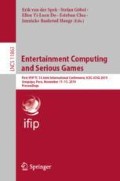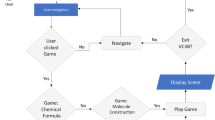Abstract
Traditional teaching strategies have become increasingly unattractive and demotivating for students in general. Students of inorganic chemistry usually have difficulties in learning the atomicity of the elements during the composition of the chemical compounds, as well as in the understanding of the characteristics and functions of such compounds. This work presents Quimi-Crush, a tile-matching digital puzzle capable of stimulating students to learn and participate in the understanding of inorganic chemistry concepts in a playful and fun way.
Similar content being viewed by others
Keywords
1 Introduction
The teaching of chemistry provides students a basic knowledge on specific phenomena in nature [4]. However traditional strategies of chemistry teaching are often seen as discouraging by students, since such strategies are based on memorization of formulas and calculations making the learning process less enjoyable [5].
As a result, more dynamic and attractive new approaches need to be incorporated into the chemistry learning and teaching process, in order to create a friendly and welcoming environment to promote a playful approach to learn inorganic chemistry [1].
Regarding serious games, “they combine the entertainment value of games with additional objectives such as players acquiring knowledge or skills, receiving guidance and feedback on tasks to perform, or contributing partial solutions to problems” [2]. They are “intentionally designed to attract, engage, and retain (even addict) players by applying psychology principles” [2], whose impact for educational purposes has received considerable attention.
This paper presents Quimi-Crush, a tile-matching puzzle serious game capable of stimulating apprenticeship and participation of high school students in inorganic chemistry learning-teaching process.
2 The Quimi-Crush Game
Quimi-Crush is similar to famous match-3 puzzle games, like “Fat Princess - Piece of Cake” [6] and “Candy Crush - Soda Saga” [3] (Fig. 1). One of the main objectives in “Candy Crush - Soda Saga” is making a certain quantity of combinations containing objects that look like soda bottles. In order to reach that aim it is necessary to keep combining “candies” to create opportunities to release the “soda bottles” objects. In “Fat Princess-Piece of Cake”, the player must defend himself from waves of enemies that increase according the progress of the player in the game. The player team has characters that perform attack and defense actions from the combination of pieces on the board.
Regarding Quimi-Crush, the player controls actions of a hero by combining chemical components in order to perform attacks on the villain, and the player character suffers a damage when compounds that are not oxides are combined. In principle, the spot where combinations occur has a six by six dimension, initially containing five chemical elements: Hydrogen (H), Carbon (C), Sodium (Na), Nitrogen (N) and Oxygen (O) (Fig. 2).
The dynamics of the game consists of turns, in which player searches for basic chemical elements that are able to combine with each other (Hydrogen, Carbon, Sodium, Nitrogen and Oxygen) according to a catalog of combinations (Fig. 3). For each combination of basic elements that does not generate an oxide, the hero of the game will take damage in the turn and consequently lose a heart. When the combination of components produces an oxide, the hero will attack and the villain will lose a heart.
If the player manages to combine enough oxides to destroy all hearts of the enemy, he wins the match. The player loses the match when the number of simple combinations that do not generate oxides is greater than the total number of hero hearts. In case of victory, a new level is unlocked, otherwise, the player will have to try to play the same level again or return to the initial menu.
If the player delays to find a possible item to be combined, the game signals a possible match that can be performed, but this combination will not be necessarily the best for the victory. However, if there are really no combinations, the component area is scrambled again. An introductory tutorial is also provided by the game, thus facilitating the explanation of the basic dynamics of the game itself.
3 Conclusions and Future Work
Quimi-Crush presents an innovative approach to the teaching of inorganic chemistry. Through the blending of rules and goals of tile-matching puzzle games known to young audiences, the game is able to dynamically exercise the knowledge of atomicity of proposed base chemical elements. As a result, there is an interesting didactic resource in the teaching of inorganic chemistry, which can easily be extended to different inorganic chemical compounds and other known chemistry concepts.
As future work, besides extra improvements and corrections to become more aesthetically attractive for the players, it is intended to evaluate the game usability in the process of teaching public high school students. For this, the game will be applied in both the mobile version and in public school PCs in the region. Mobile and desktop versions of the game, together with developed source code, will also be available at https://github.com/lenda-uefs after the necessary fixes and adjustments.
References
de Barros, C.F.: Jogos no ensino de quımica: um estado da arte sobre a revista quımica nova na escola (2016)
Dalpiaz, F., Cooper, K.M.: Games for requirements engineers: analysis and directions. IEEE Softw. (2018)
Dockterman, E.: Candy crush saga: the science behind our addiction. http://business.time.com/2013/11/15/candy-crush-saga-the-science-behind-our-addiction/ Novembro 2013. Accessed 01 July 2019
de Fátima Rocha, M., de Lima, I.C., Victor, C.M.B., Iany Silva de Santana, L.P.D.S.: Jogos didáticos no ensino de química. Formação de Professores: interação Universidade (2011)
Oliveira, L.M.S., da Silva, O.G., da Silva Ferreira, U.V.: Desenvolvendo jogos didáticos para o ensino de química. Holos, U.V. (2010)
One Loop Games LLC: Fat princess: Piece of cake. https://www.playstation.com/pt-br/games/fat-princess-piece-of-cake-psvita/
Author information
Authors and Affiliations
Corresponding author
Editor information
Editors and Affiliations
Rights and permissions
Copyright information
© 2019 IFIP International Federation for Information Processing
About this paper
Cite this paper
Cunha, O.A.L., Gonçalves, J.B., Sarinho, V.T. (2019). Quimi-Crush: A Digital Game for the Teaching of Inorganic Chemistry. In: van der Spek, E., Göbel, S., Do, EL., Clua, E., Baalsrud Hauge, J. (eds) Entertainment Computing and Serious Games. ICEC-JCSG 2019. Lecture Notes in Computer Science(), vol 11863. Springer, Cham. https://doi.org/10.1007/978-3-030-34644-7_34
Download citation
DOI: https://doi.org/10.1007/978-3-030-34644-7_34
Published:
Publisher Name: Springer, Cham
Print ISBN: 978-3-030-34643-0
Online ISBN: 978-3-030-34644-7
eBook Packages: Computer ScienceComputer Science (R0)








